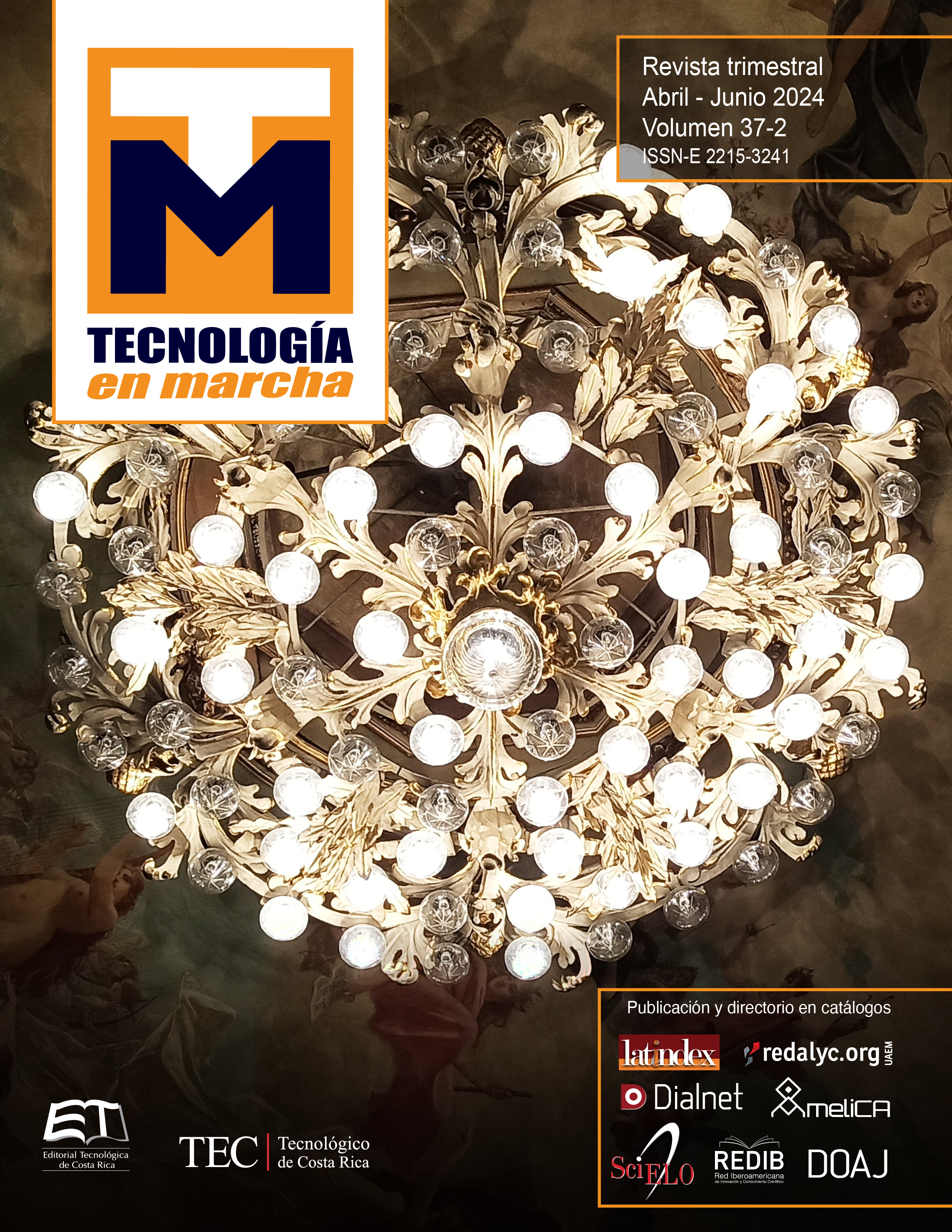Water footprint in the construction process as an indicator of sustainability: a case study for Costa Rica
Main Article Content
Abstract
The main objective of the research was to determine the feasibility of using the Water Footprint (WF) as an environmental indicator in the construction sector, for which a field quantification of this indicator was carried out in four selected single-family housing residential projects in the Greater Area. Metropolitana de Costa Rica, seeing construction as a productive process, and analyzing the results by activity and globally. The direct blueprint in the construction process was calculated through field measurements, carrying out weekly inspections of each project, thus assigning a water consumption per activity according to the progress that was observed. The indirect water footprint (blue and green) for the materials was estimated, based on a series of data on the use of water in production, consulted from the available environmental declarations of each product. Due to the lack of data available in the national context, gray HH could not be estimated. It is concluded that the results obtained could be considered as a first advance in the calculation of HH in the construction industry. To achieve a standard at the national level, it is necessary to encourage local producers or importers to develop environmental product declarations for construction materials and thus generate a robust database on water consumption in their production process. In addition, it is necessary to improve the practices of direct use of water in construction and the quantification of consumption as an indicator of efficiency in potential water savings.
Article Details

This work is licensed under a Creative Commons Attribution-NonCommercial-NoDerivatives 4.0 International License.
Los autores conservan los derechos de autor y ceden a la revista el derecho de la primera publicación y pueda editarlo, reproducirlo, distribuirlo, exhibirlo y comunicarlo en el país y en el extranjero mediante medios impresos y electrónicos. Asimismo, asumen el compromiso sobre cualquier litigio o reclamación relacionada con derechos de propiedad intelectual, exonerando de responsabilidad a la Editorial Tecnológica de Costa Rica. Además, se establece que los autores pueden realizar otros acuerdos contractuales independientes y adicionales para la distribución no exclusiva de la versión del artículo publicado en esta revista (p. ej., incluirlo en un repositorio institucional o publicarlo en un libro) siempre que indiquen claramente que el trabajo se publicó por primera vez en esta revista.
References
Programa Estado de la Nación. “Informe Estado de la Nación en Desarrollo Humano Sostenible”. 2018.San José, Costa Rica
Instituto de Normas Técnicas de Costa Rica. “Hogares ticos consumen más agua que resto de centroamericanos”. 2018. https://www.inteco.org/blog/noticias-2/hogares-ticos-consumen-mas-agua-que-resto-de-centroamericanos-146#:~:text=La%20%E2%80%9CGu%C3%ADa%20pr%C3%A1c tica%20para%20el,utiliza%20en%20el%20servicio%20sanitario.
Water Footprint Network. “Product Water Footprints”. 2016. https://waterfootprint.org/en/resources/interactivetools/product-gallery/
Universidad Catolica. Santo Toribio de Mogrovejo. “APLICACIONES DEL AGUA EN LA INGENIERÍA CIVIL”. 2014. Perú
Colegio Federado de Ingenieros y Arquitectos (CFIA). “Programa Bandera Azúl Ecológico Categoría Construcción Sostenible”. 2017. San José, Costa Rica
Cámara Costarricense de la Construcción (CCC). “Guía Construcción Sostenible”. 2016. San José, Costa Rica
Castillo, J. “Metodología para el control y análisis del consumo de agua durante la fase constructiva de obra gris”. 2021. (Trabajo final de graduación para obtener el grado de Licenciatura en Ingeniería Civil). Universidad de Costa Rica.
Naciones Unidas. (UN). “Objetivo 6 del Desarrollo Sostenible: Garantizar la disponibilidad de agua y su gestión sostenible y el saneamiento para todos”. Nueva York, Estados Unidos. 2021. https://www.un.org/sustainabledevelopment/es/water-and-sanitation/
Naciones Unidas. (UN). (2021). “Objetivo 12 del Desarrollo Sostenible: Garantizar modalidades de consumo y producción sostenible”. Nueva York, Estados Unidos. 2021. https://www.un.org/sustainabledevelopment
Hoekstra, A. Chapagain, A. Aldaya, M. y Mekonnen, M. “Manual de evaluación de huella hídrica”. Londres, Inglaterra, Washington DC, Estados Unidos. 2011. https://waterfootprint.org/media/downloads/TheWaterFootprintAssessment Manual_2.pdf
CAP Acero. “Steel reinforcing bar (weldable and nonweldable)”. 2020.Santiago, Chile
ASTM. “NORMAL-WEIGHT AND LIGHT-WEIGHT CONCRETE MASONRY UNITS AS MANUFACTURED BY MEMBERS OF THE CANADIAN CONCRETE MASONRY PRODUCERS ASSOCIATION (CCMPA) ”. 2016. Ontario, Canada.
Wood Solutions design and build. “Environmental Product Declaration Softwood Timber”. 2020. Australia
Wood Solutions design and build. “Environmental Product Declaration Hardwood Timber”. 2020. Australia.
Wood Solutions design and build. “Environmental Product Declaration Plywood Timber”. 2020. Australia.
Holcim. “Environmental Product Declaration in accordance with ISO 14025:2006 and EN 15804:2012 Average Aggregate”. 2020. Rumania
Iplex Pipelines. “ENVIRONMENTAL PRODUCT DECLARATION PVC PRESSURE PIPES FOR BUILDING APPLICATIONS”. 2020. Australia.
Iplex Pipelines. “ENVIRONMENTAL PRODUCT DECLARATION PVC NON PRESSURE PIPES FOR BUILDING APPLICATIONS”. 2020. Australia.
Cementos Bio Bio. (CBB). “Environmental Product Declaration In accordance with ISO 14025 and EN 15804 for: Ready-Mix Concrete G025 (10)-20-12-28-B”. 2018. Santiago, Chile.
Holcim. “Environmental Product Declaration in accordance with ISO 14025:2006 and EN 15804:2012 Cemento industrial”. 2019. Cartago, Costa Rica
Holcim. “Environmental Product Declaration in accordance with ISO 14025:2006 and EN 15804:2012 Cemento fuerte”. 2019. Cartago, Costa Rica.
Plycem. “Declaración Ambiental de Producto De acuerdo con ISO 14025 y EN 15804:2012+A1 para: Plyrock”. 2020. Costa Rica.
Plycem. “Declaración Ambiental de Producto De acuerdo con ISO 14025 y EN 15804:2012+A1 para: Trims”. 2020. Costa Rica.
Plycem. “Declaración Ambiental de Producto De acuerdo con ISO 14025 y EN 15804:2012+A1 para: Fibrolit”. 2020. Costa Rica.
Plycem. “Declaración Ambiental de Producto De acuerdo con ISO 14025 y EN 15804:2012+A1 para: Plystone”. 2020. Costa Rica.
Plycem. “Declaración Ambiental de Producto De acuerdo con ISO 14025 y EN 15804:2012+A1 para: Siding”. 2020. Costa Rica.
Plycem. “Declaración Ambiental de Producto De acuerdo con ISO 14025 y EN 15804:2012+A1 para: Siding”. 2020. Costa Rica.
Ternium México. “Environmental Product Declaration In accordance with ISO 14025:2006 and EN 15804:2012 for Galvanized, painted and die rolling steel manufactured”. 2019. México
Ternium México. “Environmental Product Declaration In accordance with ISO 14025:2006 and EN 15804:2012 for Ternium TRD 91.5 Roof Deck”. 2019. México.
Ternium México. “Environmental Product Declaration In accordance with ISO 14025:2006 and EN 15804:2012 for Steel Building Structure Products manufactured”. 2019. México

